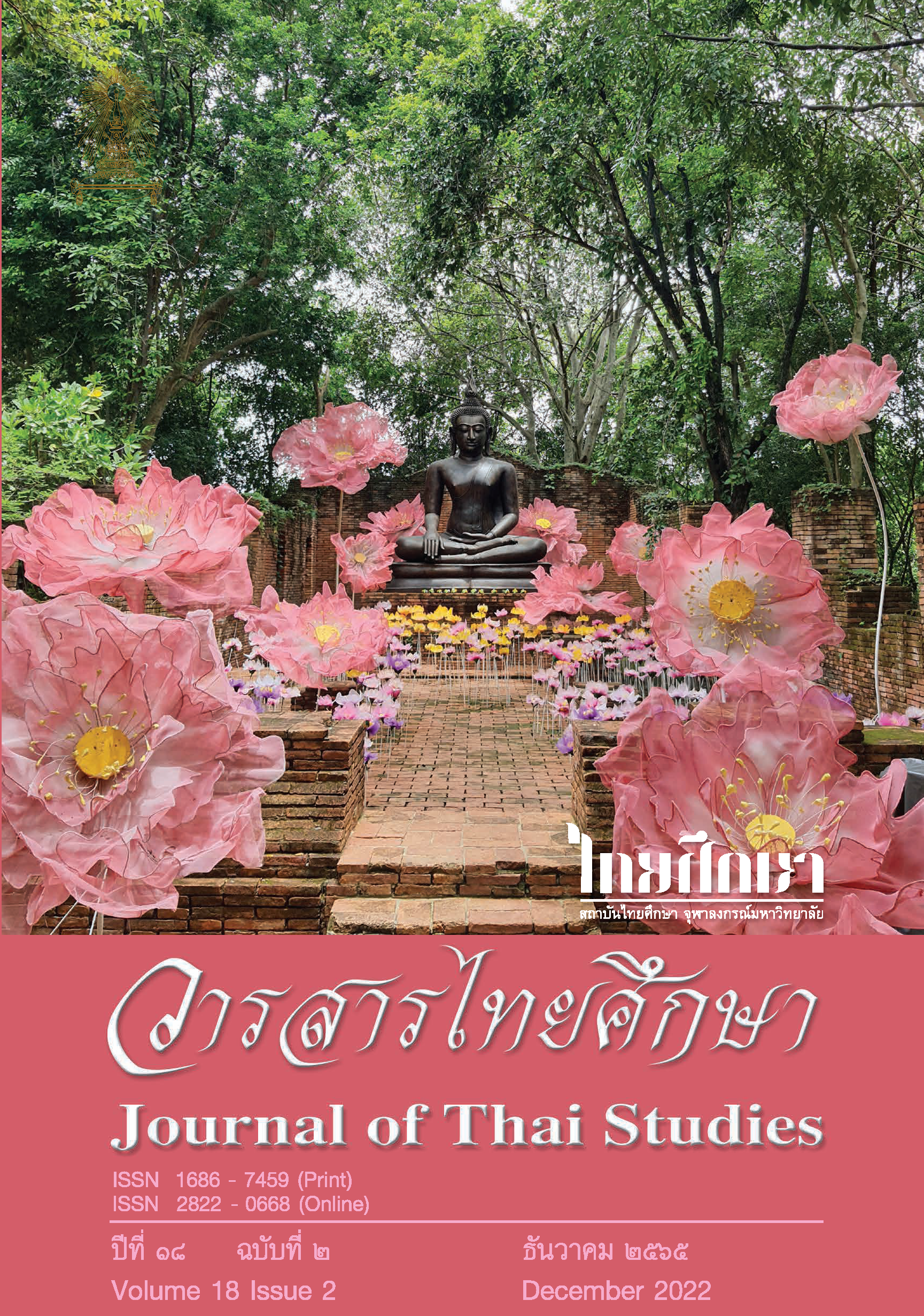Phi Mon Beliefs of the Chet Rio’s Mon Ethnic Community: Their Function as Resource Allocation Mechanisms
Main Article Content
Abstract
The research for this article studied the function of resource allocation toward the Phi Mon beliefs of the Chet Rio’s Mon ethnic community, Amphoe Banphaeo, Changwat Samutsakhon. The field data were collected from their ways of practices and rituals based on the Phi Mon beliefs through interviews, observations and participatory observations. The study found that the Phi Mon beliefs have divided people in the Mon ethnic community into different spiritual families, namely Phi Tao, Phi Gai, Phi Ngu and Phi Pla Lhai. In addition, their ways of practices and rituals based on the Phi Mon beliefs have played a part in resource allocation through animal symbolism that connects ritual relations with these spiritual family members. Similarly, “stealing” is considered a special practice that provides ritual license and a taboo that forbids members of different spiritual families from celebrating in the same year. These functions are the objectives behind the beliefs of the Mon ethnic community that were developed in the past and have been carried on to the Chet Rio’s Mon ethnic community today.
Downloads
Article Details

This work is licensed under a Creative Commons Attribution-NonCommercial-NoDerivatives 4.0 International License.
Journal of Thai studies is licensed under a Creative Commons Attribution-Noncommercial-NoDerivatives4.0 Intenational (CC BY-NC-ND 4.0) licence, unless otherwise stated. Plese read our Policies page for more information on Open Access, copyright and permissions.
References
Bunjoon, O. (2004). Prawattisat lae thinthan chao mon samutsakhon [History and Settlement of the Samut Sakhon Mon]. In 80 pi sattrachan kiatkhun naiphaet su-ed khotcha seni 48 pi samakhom thai raman (p.198-220) [80 Years Emeritus Professor Dr. Su-ed Gajaseni 48 YearsThai-Raman Association]. Nichaiyok, S. (ed.). Bangkok: Thai Raman Association.
________. (2016). “BAN THUNG-KHEN”: The Contemporary Mon ethnic community of Suphanburi. (Doctoral disseration). Thammasat University, Bangkok, Thailand.
Brown, A.R. Radcliffe. (1952). Structure and Function in Primitive Society, Illinois: The Free Press.
Chaisingkananon, S. and Phothimani, C. (2018). phukhon kan khlueanyai lae saisamphan [People, migrations and Inter-ethnic relation in Samut Sakhon] in Sakhonburi chak withi chaoban: kan plianplaeng phan withichiwit thongthin nai lum - maenam Tha chin changwat
Chanchaona, S. (2021, November 11). Personal Interview
Chanchaona, T. (2020, June 24). Personal Interview
Chitsathaphon, W. (2006). A Study of the Peguan Spirits dance among Thai Raman, people in Banmaung, Banpong district, Ratchaburi province. (Master’s thesis). Srinakharinwirot University, Bangkok, Thailand.
Durkheim, Emile. (1995). The Elementary Forms of Religious Life, (K. Fields, Trans). New York: The Free Press.
Foster, B. L. (1973). “Ethnic Identity of the Mons in Thailand”. Journal of the Siam Society, 1(61), 203-226.
Feungfusakul, A. (2008). Anthropology of Religion: Basic concepts and theoretical arguments. Bangkok: Chiang Mai University.
Halliday, R. (1914). The Kalok dance of the Talaings. Journal of the Burma Research Society, 4, 93-101.
________. (1917). The Talaings. Bangkok: Orchid Press.
Gajaseni , S. (2004). Watthanatham prapheni mon [Mon Traditions and Culture]. In 80 pi sattrachan kiatkhun naiphaet su-ed khotcha seni 48 pi samakhom thai raman (p.70-83) [80 Years Emeritus Professor Dr. Su-ed Gajaseni 48 Years Thai-Raman Association]. Nichaiyok, S. (ed.). Bangkok: Thai Raman Association.
Khrueawitchayachan, C. (2005). Important Mon traditions (2nd ed.). Bangkok: Princess Chakri Sirindhorn Anthropology Centre.
Na thalang, S. (2014). Thritsadi khati chon witthaya withi witthaya nai kan wikhro tamnan - nithan phuenban [Folklore theory: analysis methodology of myths and folktales]. Bangkok: Thammasat University.
Ocharoen, S. (1998). Mon nai mueangthai [Mons in Thailand]. Bangkok: Thammasat University.
________. (2009). Mon nai mueangthai: kan opphayop thana lae kan phasom klomkluen [Mons in Thailand: Immigration, status, and assimilation]. In Mon nai phaendin Siam [In, Mons in Siam (p.1 - 34)]. Ratho, M. and Khanthawichai, K. (ed.). Bangkok: Institute of Asian Studies Chulalongkorn University.
Ochima, A. (1993). Life, Ritual and Ethnic Identity of the Mons in Thailand A Case Study of Banpong District, Ratchaburi Province. (Master’s thesis). Thammasat University, Bangkok, Thailand.
Rebanko P. (2022, May 3). Personal Interview.
Santasombat, Y. (2016). Manut kap watthanatham [Humans and culture]. Bangkok: Thammasat University.
Sombun S. (2022, May 6). Personal Interview
Sombunchan S. (2019, August 18). Personal Interview
Songmit, C. (2004). Spirit – Dance ritual of the Mon Thais: the significance and role in cultural transmission. (Master’s thesis). Chulalongkorn University, Bangkok, Thailand.
Songsakun, S. (1987). Sing thi nasonchai kiaokap chet rio [Interesting things about Chet Rio]. Bangkok: Raksip.
Suwanphanchu K. (2022, May 8). Personal Interview
Wanliphodom, S. (2004). Lumnam mae klong mi khon yuk hin pen ban pha chon khon yuk patchuban [Mae Klong River Basin, the Stone Age People are the Forebear of the Current People] in Lumnam mae klong prawattisat chattiphan mon [In, Mae Klong river basin, ethnic history of the Mon “kinship” (p.27 - 80)]. Wongthet, S. (ed.). Bangkok: Matichon.
Wannapan, P. (2006). A study of belief in Mon’s ritual folk dance in Bangkradi Community. (Master’s thesis). Srinakharinwirot University, Bangkok,Thailand.
Yaimai, F. (2021, November 11). Personal Interview.


